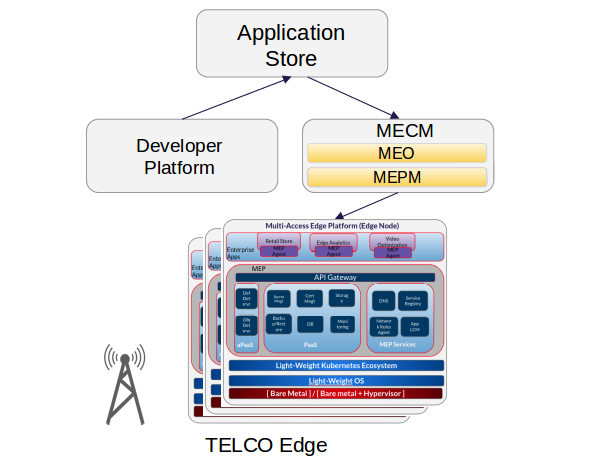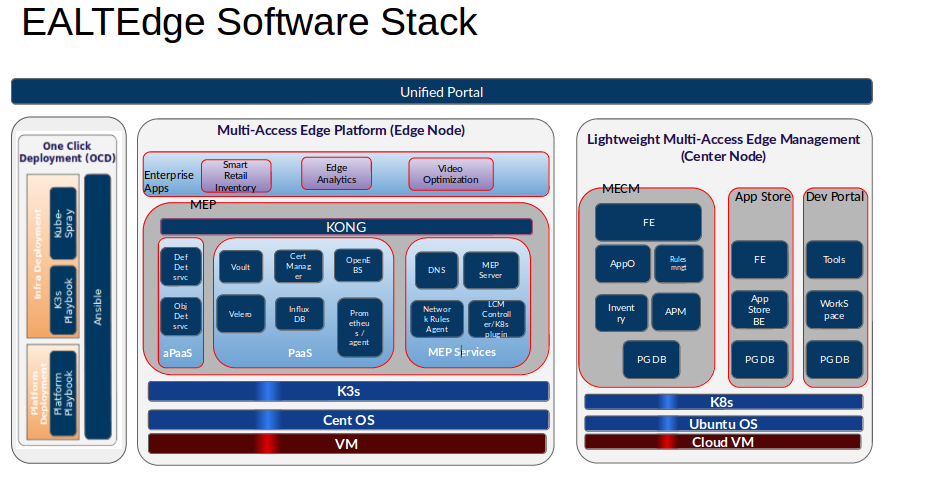...
The Enterprise Applications on Lightweight 5G Telco Edge platform architecture consists of a MECM (Controller) Cluster (Cloud) and single to multiple MEC Host Sites .The MECM Cluster is a Central Cloud Server which controls the deployment of applications on MEC Hosts. The MECM node can be a single node or a multiple node K8S ClusterOne Click Deployment Node(OCD host), Center Node and single to multiple Edge Nodes .
Overall architecture diagram of the blueprint.
Figure 1 – EALTEdge R3 R4 Architecture
CENTER
CENTER Node consists of 3 components. MECM , Applcm and Developer Platform. MEC Manager is the central entity in the MEC system responsible for application and service deployment in an highly distributed computing environment, it provides overall view of hosts and applications deployed in the hosts. MEC Manager is the central entity in the MEC system responsible for application and service deployment in an highly distributed computing
environment, it provides overall view of hosts and applications deployed in the hosts.
MECM comprises of MEP manager which performs the following tasks
➢ Application Package Management: On-boarding of application packages and if necessary adjusting them to comply with operator policies, keeping a record of on-boarded packages
➢ Applicatin LCM: Selecting appropriate MEC host(s) for application instantiation based on user inputs, keeping record of instantiated applications on specified hosts. Also carries out other LCM operations like query, deletion, termination etc.
...
- Portal: Portal provides the user interface to publish and launch App applications. and has option for user to comment on the application in comment section and give ratings.
- Appstore Services: App Store services where uploading an App package and verifies the upload.
- PGDB : Open source PostgreSQL database is being used to store the information, Recommended version is 12.3.
Developer Platform:
- Tools: Developer tools are used in Plugin Management, Plugin Life Cycle and grading systems making it more convenient for developers to develop applications and integrate them into the edgegallery platform.
- Workspace: Developers manage their own Application development process by creating projects or migrating projects. Developers can manage project, app package and test task management.
- PG DB: PostgreSQL database version 12.2 is being used.
EDGE Node Components:
MEP:
MEP Provides API Gateway to achieve the below functionalities
- aPaaS:
- Defect Detection Service: This is a service to detect the defect when PCB images provided
- Object Detection Service: This service can be used by developer app for various Object detection for example Bottle detection and count for Retail store inventory.
- PaaS:
- Secret Management: Platform services and developer apps can use this service for sensitive info storing like password, cert etc.
- Cert Management: Platform services and developer apps can use this service for automate certifications management.
- Storage: Edge native storage for enterprise sites.
- Backup / Restore: scheduled backup, disaster recovery for remote sites
- DB: common DB for applications data
- Monitoring: system and apps health monitoring.
- MEP Services:
- DNS: DNS server and DNS record management service
- Service Registry: Service registry and discovery, availability notifications
- Network Rules management: service for handling data plane traffic rules.
- AppLCM: applications life cycle manage.ment
Software Platform Architecture
The below image shows the software platform distribution and architecture for Release 4.0.
EALTEdge Software Components
...
- Front End: AppStore is a market for developers to publish and launch App applications. Appstore FE provides the registration interface to the new user and once login the store home is visible, where user can upload the application package across various industry domains and displays the list of application along with the deatils. User has option to comment on the application in comment section and give ratings. Deleting option is also available in "My App/My APP" section.
- Appstore Backend: AppStore is a market for developers to publish and launch App applications. After uploading an App package, it must pass the test first. Only the apps that pass the test can be officially launched.
- Postgres DB: The AppStore database uses an open source PostgreSQL database, and the recommended version is 12.2. Which Stores app information, application package information and review details of the application.
Developer Platform:
- Tools: Developer tools are used in Plugin Management, Plugin Life Cycle and grading systems making it more convenient for developers to develop applications and integrate them into the edgegallery platform.
- Workspace: Developers manage their own Application development process by creating projects or migrating projects. Developers can manage project, app package and test task management.
- Postgres DB: PostgreSQL database version 12.x is being used.
EDGE Node Components:
MEP:
MEP Provides API Gateway to achieve the below functionalities
- aPaaS:
- Defect Detection Service: This is a service to detect the defect when PCB images provided
- Object Detection Service: This service can be used by developer app for various Object detection for example Bottle detection and count for Retail store inventory.
- PaaS:
- Vault: Vault is is a tool for securely accessing accessing secrets. A A secret is is anything that you want to tightly control access to, such as API keys, passwords, certificates, and more. Vault provides provides a unified interface to any any secret while while providing tight access control and recording a detailed audit log.
- Cert Management: cert cert-manager is a native native Kubernetes certificate certificate management controller. It can help with issuing certificates from a variety of sources, such as as Let’s Encrypt, HashiCorp Vault, Venafi, a simple signing key pair, or self signed. It will ensure certificates are valid and up to date, and attempt to renew certificates at a configured time before expiry.
- OpenEBS: OpenEBS is a Kubernetes native hyperconverged storage solution. OpenEBS consumes the storage (disks, SSDs, cloud volumes, etc) available on the Kubernetes worker nodes to dynamically provision Kubernetes Persistent Volumes.
OpenEBS can provision different type of Local PV for Stateful Workloads like Cassandra, MongoDB, Elastic, etc that are distributed in nature and have high availiability built into them. Depending on the type of storage attached to your Kubernetes worker nodes, you can select from Dynamic Local PV - Hostpath, Device, ZFS or Rawfile.
- Velero: Velero is is an open source tool to safely backup and restore, perform disaster recovery, and migrate Kubernetes cluster resources and persistent volumes.
- Influx DB: Time series data base for user applications data.
- Prometheus Agent: cAdvisor, NodeExporter
- MEP Services:
- DNS: The MEP platform provides the domain name resolution services to the applications deployed in the EdgeGallery MEC, which can be utilized by the device applications in UE. MEC platform receives the DNS configurations from the MEC management, which includes the FQDN(Fully Qualified Domain Name), IP address and related entries. MEC applications can later query or modify the state of these configurations.
- MEP server: MEP platform services like service registry, discovery, DNS, traffic rules etc. MEP provides service registration, update, delete, and query related API interfaces. Applications can register, update, delete, and query services through LDVS-MEP. The The service registry provides visibility of the services available on the MEC server. It uses the concept of loose coupling of services, providing flexibility in application deployment. In addition, the service registry presents service availability (status of the service) together with the related interfaces and versions. It is used by applications to discover and locate the end-points for the services they require, and to publish their own service end-point for other applications to use. The access to the service registry is controlled (authenticated and authorised).
- AppLCM: LCM controller and K8s plugin. Handles the application life cylce, where lcmController is mainly communicates with K8s plugin to upload config, remove config, instantiate, terminate,and query an application. It also provides APIs to query mep capabilities and kpi information from prometheus.
Below are details of Upstream and Opensource software's used in various nodes of EALTEdge Environment.
...

